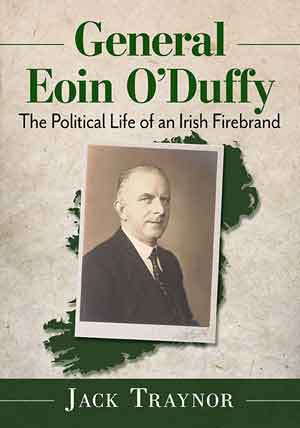
JACK TRAYNOR
McFarland Books
£49.71
ISBN 9781476693262
Reviewed By Brian Hanley
Brian Hanley is the presenter of the ‘Dirty War in Dublin’ podcast, supported by a Royal Irish Academy Decade of Centenaries bursary.
In December 1944 General Eoin O’Duffy, the former leader of Ireland’s best-known fascist movement, the Blueshirts, was buried with full military honours at Glasnevin. The mourners included Taoiseach Eamon de Valera and several members of his cabinet, including Oscar Traynor and Frank Aiken. They attended despite O’Duffy’s having fought them in the Civil War, plotted a coup to prevent their coming to power and having led sometimes violent opposition to their government. Their presence complicates our view of irreconcilable Civil War bitterness. Jack Traynor’s new study of O’Duffy also raises questions about changing attitudes to contentious commemoration. In his native Monaghan, one of the terraces at Tiarnach’s Park in Clones is named after O’Duffy. The local GAA honoured him without controversy as recently as 2009, but when his image was included in a mural on a Monaghan school during 2021 it was removed after an outcry. There is some irony in this. In 1936 O’Duffy’s National Corporate Party (NCP) demanded the removal of symbols of British imperialism from public spaces. As Traynor notes, the controversy over the mural reflected the shift towards ‘decommemorating’ problematic historical figures.
As this book shows, however, political actors are made, not born. Had O’Duffy been killed during the struggle for independence he would be remembered as a republican hero. Already a leading figure in the GAA after joining the Volunteers during 1917, he was praised by Michael Collins as ‘the best man by far in Ulster’. The Monaghan man was an important figure in the IRA’s war, firstly in his native county and then in Fermanagh and Tyrone. He earned a reputation for eagerness to respond to loyalist assaults on nationalists and was respected by Belfast republicans for his role in the city during the Truce. His support for the Treaty did not mean that he eschewed military action against Northern Ireland. With regard to potential unionist resistance, O’Duffy told the Dáil in 1921 that he ‘had dealt with them [loyalists] by force … and those people were now silent’. He later warned that ‘if the Orangemen were to murder our people … then they should get the lead’.
O’Duffy was a central figure in the early stages of the Civil War, part of a three-man Army Council along with Collins and Richard Mulcahy. Though later accused by republicans of making ‘Kerry a graveyard’, O’Duffy had little part in the worst atrocities of the war, having moved over to a policing role after Collins’s death. But Traynor notes that O’Duffy had lobbied for executions, especially if the captured anti-Treaty men were ‘Truceillers’, peacetime recruits, for whom he had special contempt. Thereafter he played a major part in shaping the Gardaí, emphasising Catholic piety, the Irish language and athletic ability for its officers. For O’Duffy rural recruitment was vital; ‘the son of a peasant is the backbone of the force’. In contrast, he described some of Dublin’s population as ‘city scum’, and by the late 1920s he expressed growing pessimism about the moral character of the Irish people. Interestingly, as commissioner he was hostile to allowing uniformed groups to march on Armistice Day; these objections were eagerly quoted back to him by Fianna Fáil ministers in 1933. That party’s election victories had a traumatic impact on Cumann na nGaedheal, making fascist alternatives seem attractive to some of its leaders.
Traynor argues that O’Duffy ‘emerged from and existed within the political ecosystem of the pro-Treaty nationalist coalition’. The focus on his personality sometimes deflects attention away from ‘problematic views shared by various pro-Treaty leaders’. Despite the comforting notion that moderate ‘constitutionalists’ in Fine Gael soon removed O’Duffy from its leadership, there was widespread sympathy for fascist ideas among many in the party. There are always varieties of fascism, often with intense rivalries between different factions. Hitler and Mussolini, for instance, were not allies for much of the 1930s and established competing ‘internationals’, both of which attracted Irish adherents. O’Duffy identified with the Italian variant initially, attending a major fascist congress in Switzerland in late 1934, but Traynor shows that another Fine Gael politician, Louth TD James Edward Murphy, took part in a Berlin conference sponsored by the Nazis in the same year. During 1931 O’Duffy described communism as ‘Judaic-Masonic’ inspired. This conspiracy theory was pervasive on the Irish right, with similar rhetoric often heard at Blueshirt and, indeed, Fine Gael meetings.
Foreshadowing divisions among today’s fascists, O’Duffy’s NCP denounced Jewish migration to Palestine and supported Arab resistance to it. His relationship with British fascists was uncomfortable, his desire for a united Ireland clashing with their loyalism. Indeed, O’Duffy was at pains to stress that he remained an Irish republican, even at the height of conflict between the IRA and his movement. Despite the blow to his prestige after the disastrous ‘crusade’ in Spain, O’Duffy was sought out again by both old friends and enemies during the Second World War. By 1940 former pro-Treatyites like Ernest Blythe and J.J. Walsh were mixing with anti-Treatyites in pro-Axis grouplets. Indeed, Traynor suggests that O’Duffy became ‘reconciled with [the] militarist wing of extreme republicanism’. Alliances between erstwhile enemies under the influence of global events seem depressingly prescient. This book by a talented young historian is a valuable addition to our understanding of both republican radicalism and Irish fascism in the post-revolutionary period.
